Wisterias in Tokyo: 10 Beautiful Gardens and Parks

Purple wisterias are one of the spring highlights in Japan. We introduce 10 wisteria locations in Tokyo, including the ever-popular Kameido Tenjin Shrine. There are also night illuminations and quiet places away from the crowds to consider!
Wisterias: Adored in Japan for Centuries
The mention of spring flowers in Japan often evokes the image of cherry blossoms. But spring is also when the azaleas, peonies, and other beautiful flowers go into bloom!
Wisterias—a plant with dazzling flowers—have captivated the Japanese people for centuries. During the Heian Period (794-1185), Japanese aristocrats added wisteria patterns to their clothing. The Fujiwara clan, a powerful aristocratic family at the time, had a family crest adorned with the wisteria flower.
There are many places famous for their wisterias in Tokyo. We will introduce 10 locations that are easy to access.
10 Wisteria Spots in Tokyo
1. Kameido Tenjin Shrine
2. Nishiarai Daishi Temple
3. Hie Shrine
4. Hibiya Park
5. Imperial Palace East Gardens
6. Koishikawa Korakuen Garden
7. Kokuryo Shrine
8. Jindai Botanical Garden
9. Koganei Park
10. Haijima Park
Get the best deals on train tickets in Japan!
1. Kameido Tenjin Shrine
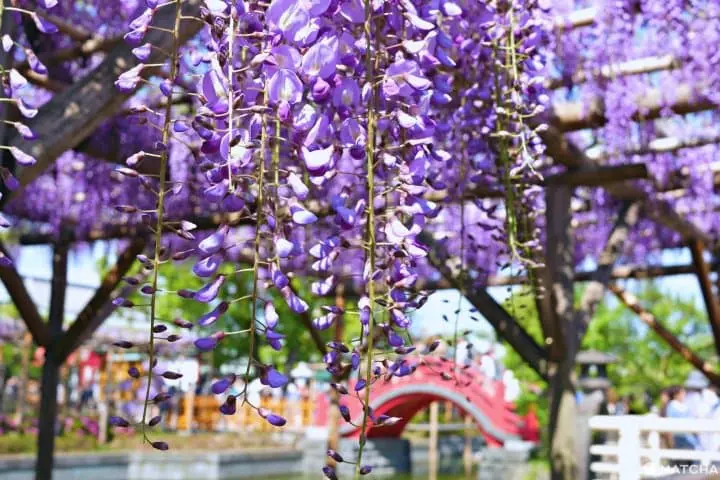
Kameido Tenjin Shrine is the most famous wisteria spot in Tokyo. The wisterias at Kameido Tenjin Shrine are even depicted in “One Hundred Famous Views of Edo,” a series of ukiyo-e (*) prints that became very popular during the Edo Period (1603-1868).
At Kameido Tenjin Shrine, flowers from over one hundred wisteria vines on 15 arbors bloom profusely every year from mid to late April. The wisteria flowers swaying in the breeze and the vermillion arched bridge have become iconic. Tokyo Skytree can also be seen from the shrine grounds.

From mid-April to early May, the Wisteria Festival is held at Kameido Tenjin Shrine every year. It becomes very lively during this time. Illuminations are also held from sunset to midnight during the festival period.
Both the wisteria canopies, reflected in the water as the vines are bathed in soft light, and the illuminated Tokyo Skytree will display a unique beauty different from the daytime. In the evening, there are fewer visitors, so you can leisurely take photos. The dates for the Wisteria Festival change slightly every year, so make sure to check the Kameido Tenjin Shrine website (Japanese) before visiting.
*Ukiyo-e: Japanese woodblock prints that became incredibly popular during the Edo Period (1603-1868).
2. Nishiarai Daishi Temple

Nishiarai Daishi Temple in northern Tokyo is home to 700-year-old wisteria trees. The flowers go into bloom before Iroha Pond, located in front of the main hall.
The flowers typically reach peak bloom around April. The vines can reach up to a meter in length if the flowering conditions are good. The soothing sound of the pond and the elegant scent of wisterias capture the atmosphere of spring in Japan.
3. Hie Shrine
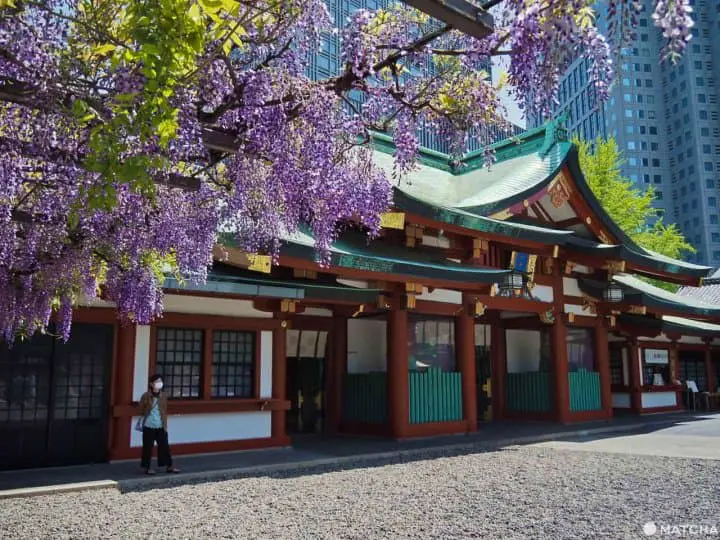
Hie Shrine is located in Nagata, a town in central Tokyo. The historical shrine was once considered the main guardian deity of Edo (Tokyo’s former name) during the Edo Period. The wisterias on either side of the shrine may not be that large, but they still delight the eyes of many.
The sound of awe can be heard when people see the wisteria flowers and their vines swaying in the breeze. This sight brings a sense of calm to the shrine grounds despite the fact that this area is surrounded by high-rise buildings.

The light purple wisteria flowers and the scarlet-colored main shrine make a gorgeous backdrop that is quite memorable.
Hotels near Hie Shrine
4. Hibiya Park

Hibiya Park—situated in central Tokyo next to office buildings and commercial facilities—is Japan’s first Western-style modern park. Within its extensive grounds, you’ll find a plaza, pond, tennis court, and tons of flower beds. The park is like an oasis in the bustling city.
There are three spots in the park for viewing wisteria flowers. We especially recommend the trees next to Kumogata Pond. You can admire the pond, fresh greenery, and wisterias while forgetting about the hustle and bustle of the city.
5. Imperial Palace East Gardens
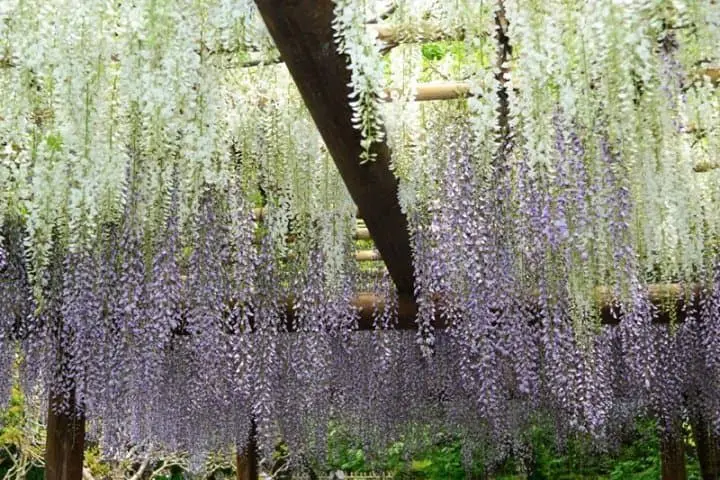
The East Gardens of the Imperial Palace is where you can enjoy flowers year-round. The wisterias by Ninomaru Pond aren't that large, but you'll be able to enjoy a combination of purple and white flowers.
Hotels near Imperial Palace East Gardens
6. Koishikawa Korakuen Garden

Koishikawa Korakuen is Tokyo’s oldest daimyo (feudal lord) garden. Picturesque sceneries from nationwide are imitated throughout the garden. They represent various landscapes including lakes, mountains, rivers, and fields.
Step into the fields, and you’ll find the grounds lined with wisteria arbors capturing visitors' attention.

In front of the wisteria arbors are fields of Japanese water iris and rabbit-ear iris. The water irises bloom in June, while the rabbit-ear iris bloom in early May, around the same time as the wisterias. If you’re lucky, you can enjoy the magnificent view of the wisteria flowers while strolling through the rabbit-ear iris fields.
You may even wonder if people in the past admired this same idyllic scenery.
Hotels near Koishikawa Korakuen
7. Kokuryo Shrine
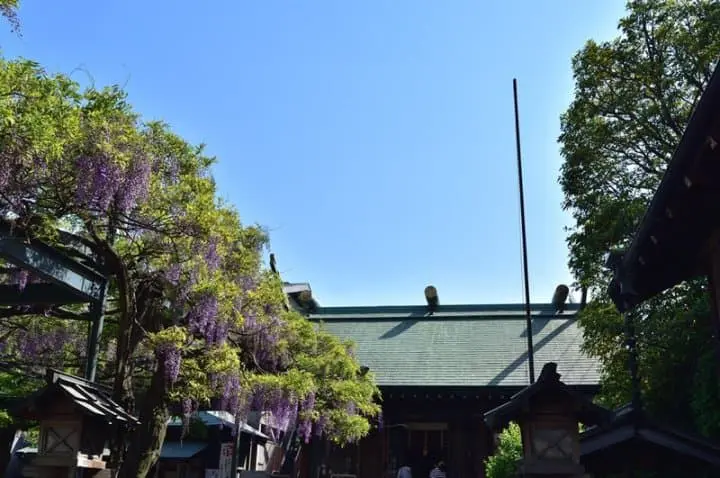
Kokuryo Shrine is found in the nature-rich Chofu, away from the buzzing city. It has a sacred wisteria tree that is estimated to be 400 to 500 years old with a wisteria arbor that has grown 400 square meters in size. This tree is called the "Sennen no Fuji" (“1000-Year-Old Wisteria”) and is venerated by many people.
A wisteria festival is held every year from mid to late April. During this season, the shrine will hand out lovely wisteria-themed goshuin stamps.
Wisteria-themed omamori (good-luck charms) and ema (wooden plaques) are sold during the wisteria season. The omamori contain seeds from the sacred "Sennen no Fuji." It is said to grant longevity and prosperity to one’s family and make your wishes come true. It also features a charming wisteria design.
8. Jindai Botanical Garden

Jindai Botanical Garden, also located in Chofu, is another well-known wisteria spot. It was originally a plant nursery growing roadside trees for the Tokyo Metropolitan Government. Now, the garden has a variety of plants and flowers including wisterias.
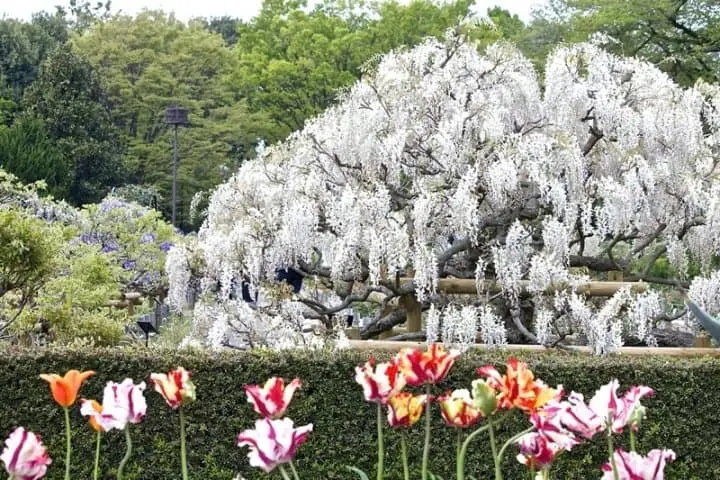
There are 49 wisterias of 13 different varieties planted in the garden. These include purple wisterias, white wisterias, and a variety that blooms with overlapping petals called yaefuji. The large variety of wisterias has slightly different blooming periods. This means you can enjoy the blooms in the garden over a longer season.
9. Koganei Park
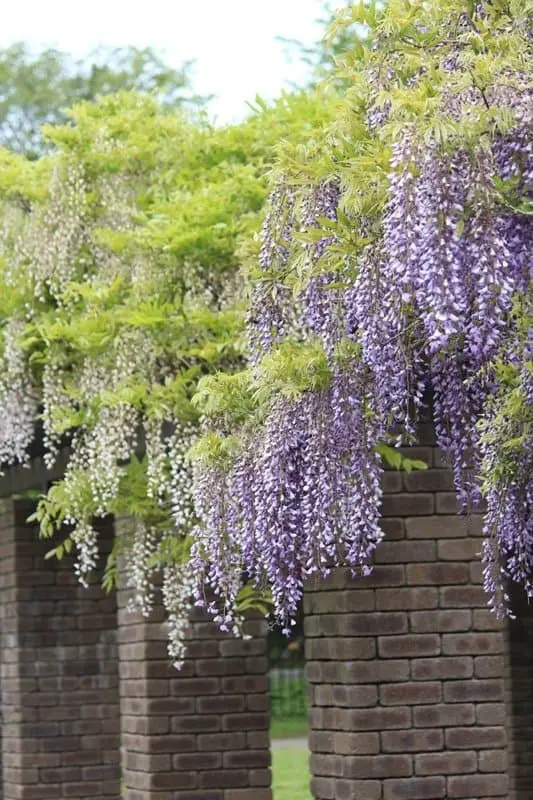
Koganei Park is a spacious park away from the busy shopping areas. It’s also a famous cherry blossom spot. You can admire both purple and white wisterias. The Edo-Tokyo Open Air Architectural Museum, an open-air museum that exhibits Japanese architecture, is located inside the park. It is a place where families can have fun for a whole day.
10. Haijima Park
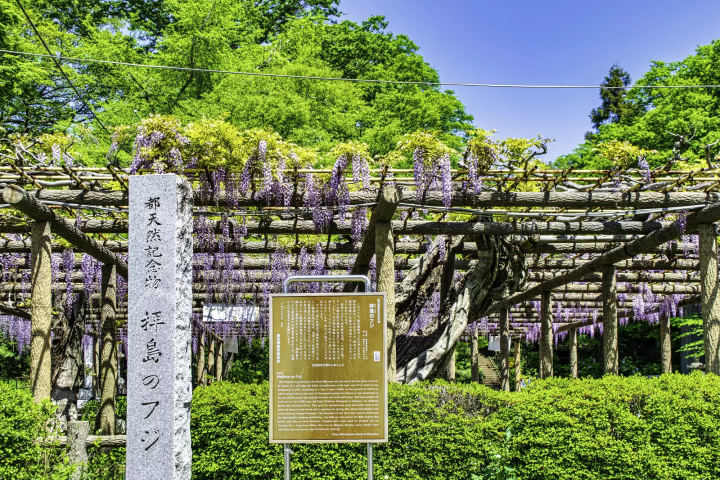
Photo by Pixta
Over 800 years old, the wisteria at Haijima Park is called the "Thousand-Year Wisteria" and is designated as a natural monument of Tokyo.
It typically blooms from late April to early May each year. Since the wisteria is located in a corner of the park, it is a hidden spot recommended for those who want to leisurely and quietly enjoy the flowers.
Additionally, there are multiple shrines and temples within the park and its surroundings, so we recommend combining your wisteria viewing with exploring these sites! Access to Haijima Park is convenient from Haijima Station via bus.
Haijima Park
Location: Tokyo, Akishima, Shimacho 1 - 10 Map
Wisterias Bloom Right After the Cherry Blossoms Fall
As shades of light pink begin to disappear from the city, a flower with sophisticated fragrance and purple hues is the next to arrive. The arrival of spring transforms the scenery of cherry blossoms into wisterias swaying in the breeze.
Make sure to admire the romantic wisterias at shrines, parks, gardens, and various other locations if you visit Tokyo in late April - early May.
Read also
I used to live in Japan and managed to conquer 78 out of the 100 famous castles and 12 existing castle towers in 8 years. As a history enthusiast, I also have a passion for baseball and Japanese dramas, which have driven me to visit all 47 prefectures. I hope to convey not only the scenery of Japan but also more of its culture and way of life.






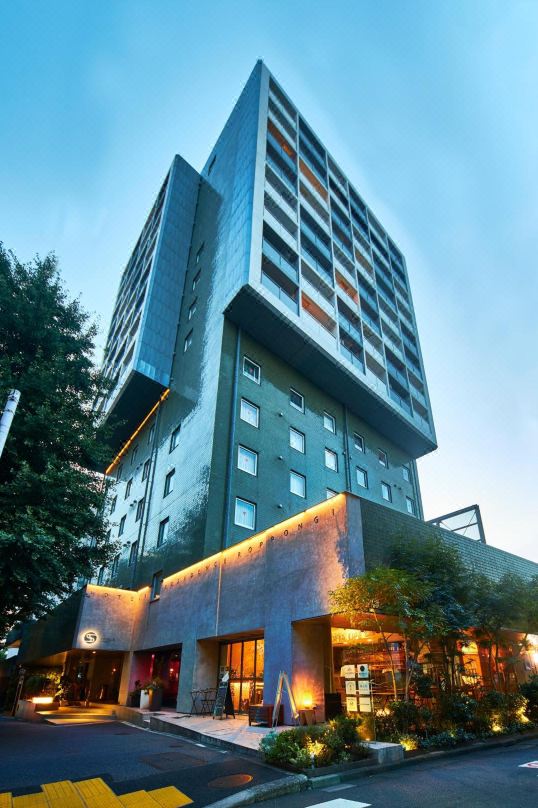










































![[2026] Top 5 Strawberry Picking Spots in Tokushima, Naruto| Farms and Access Guide for January to May](https://resources.matcha-jp.com/resize/720x2000/2025/03/06-227165.webp)



